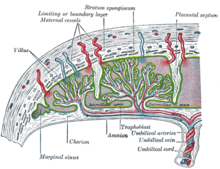Placental microbiome

The placental microbiome is the
It should be stressed that the evidence for a placental microbiome is controversial.[3][4] Most studies supporting the existence of a placental microbiome lack the appropriate experimental controls, and it has been found that contamination is most likely responsible for reports of a placental microbiome.[3][5]
The placental microbiome more closely resembles that of the oral microbiome than either the vaginal or rectal microbiome.[1]
Bacterial species and genera
Culturable and non-culturable bacterial species in the placenta obtained following normal term pregnancy have been identified.
| Binomial name | Commensal | Transient | Potential pathogen |
References |
|---|---|---|---|---|
Prevotella tannerae
|
x | x | [6][7][8] | |
| Bacillota spp | x | x | [9][10] | |
| Mycoplasmatota ssp. | x | x | [9] | |
| Fusobacterium nucleatum | x | x | [11][12] | |
| Prevotella tanerae | x | |||
| Bacteroides spp. | x | x | [10] | |
| Fusobacterium spp. | x | x | ||
| Streptomyces avermitilis | x | [10] | ||
| Neisseria polysaccharea | x | |||
| Neisseria lactamica | x | |||
| Pseudomonadota ssp. | x | [9][10] | ||
| Bacteroidota ssp. | x | [9] | ||
| Escherichia coli | x | x | [8] | |
| Escherichia ssp. | x | x | [8] | |
| Actinomycetota ssp. | x | x | [10] | |
| "Cyanobacteria" ssp. | x | [10] | ||
| Chloroflexota ssp. | x | [10] | ||
| Aquificota ssp. | x | [10] | ||
| Verrucomicrobiota ssp. | x | [10] | ||
| Vibrio ssp. | x | [10] | ||
| Burkholderia ssp. | x | [10] | ||
| Beijerinckia ssp. | x | [10] |
In a healthy placental microbiome, the diversity of the species and genera is extensive.[1] A change in the composition of the microbiota in the placenta is associated with excess gestational weight gain, and pre-term birth.[10] The placental microbiota varies between low birth weight infants and those infants with normal birth weights.[13] While bacteria are often found in the amniotic fluid of failed pregnancies, they are also found in particulate matter that is found in about 1% of healthy pregnancies.[9]
In non-human animals, part of the microbiome is passed onto offspring even before the offspring are born. Bacteriologists assume that the same probably holds true for humans.[9]
Research
The fact that germ free animals can be routinely generated by sterile cesarean section provides strong experimental evidence for the sterile womb hypothesis.
Future research may find that the microbiota of the female reproductive tract may be related to pregnancy, conception, and birth. Animal studies have been used to investigate the relationship between oral microbiota and the placental microbiota. Mice inoculated with species of oral bacteria demonstrated placental colonization soon afterwards.[14]
History
Investigations into reproductive-associated microbiomes began around 1885 by Theodor Escherich. He wrote that meconium from the newborn was free of bacteria. This was interpreted as the uterine environment being sterile. Other investigations used sterile diapers for meconium collection. No bacteria were able to be cultured from the samples. Bacteria were detected and were directly proportional to the time between birth and the passage of meconium. A 1927 study demonstrated the presence of bacteria in the amniotic fluid of those that were in labor for longer than six hours.[15]
See also
- Human microbiome
- Human microbiome project
- Human virome
- List of bacterial vaginosis microbiota
- Microbiota of the lower reproductive tract of women
- Vaginal microbiota in pregnancy
References
- ^ PMID 26493119.
- ISBN 978-3-319-31248-4.
- ^ PMID 28454555.
- S2CID 206685421.
- PMID 27338728.
- PMID 25547201.
- PMID 26428492.
- ^ a b c Todar, K. "Pathogenic E. coli". Online Textbook of Bacteriology. University of Wisconsin–Madison Department of Bacteriology. Retrieved 2007-11-30.
- ^ S2CID 206169539.
- ^ PMID 25557210.
- PMID 24793619.
- S2CID 345396.
- PMID 26287241.
- )
- PMID 28454555.
